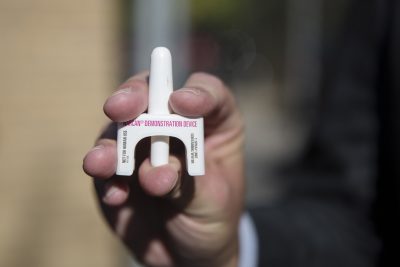Seven cities throughout the North Shore began urging residents to “Carry A Life Line” of Narcan this February in a campaign aimed at curbing opioid overdoses.

“Carry A Life Line” encourages residents to have Narcan — a nasal spray formulation of the drug naloxone, which can rapidly block the effects of opioids and reverse an overdose after a user’s breathing has slowed or stopped.
Naloxone prescriptions doubled from 2017 to 2018, according to the Centers for Disease Control and Prevention. But rural counties were almost three times as likely to be considered “low dispensing” than urban counties.
Jennifer Beloff, director of client and housing services at Action Inc., a group that has worked on the campaign for about two years, said she’s used Narcan and keeps it in her house — she has also educated her children on how to administer it and how to identify an overdose.
“Most people have a fire extinguisher in their house,” Beloff said. “You don’t want to use it, but you’re glad to know it’s there when you need it.”
Before “Carry A Life Line,” Beloff said she was a member of an earlier working group of North Shore cities that worked to remove the stigma around naloxone use.
“There’s still a lot of stigma around having access to Narcan,” Beloff said. “People don’t want to go into the pharmacy because you wait in line, and then you have to go up and say, ‘I’d like to get a refill or get a prescription of Narcan.’ And in small towns and cities, people talk.”
A prescription is not needed to obtain naloxone kits at Massachusetts pharmacies, and members of MassHealth, among other insurance companies, can obtain the kits without a copay.
Beloff said “Carry A Life Line” came out of a “secret shopper campaign,” where the working group sent members of the community to pharmacies for Narcan to gauge how easy they could obtain the medication.
“We got varying results back,” Beloff said. “Some people were treated nicely, others were not very welcomed. Some had zero copays, some people paid up to $60.”
Beloff added that the group didn’t receive any education on opioid overdose and warning signs at pharmacies when the medication was available.
After the “secret shopper” experiment, Beloff and other North Shore representatives formed the “Carry A Life Line” campaign in February, she said.
Beloff said the team worked specifically on the logo, which ended up including an orange life preserver — “an emergency life-saving tool that most people are familiar with.”
The campaign has put Narcan information in public places, such as billboards and bus stops, Beloff said.
“You don’t just want to administer Narcan and walk away,” she said. “You still want to call 911, the person still should get medical screening. The naloxone can wear off, and the person can slip back into an overdose state.”
Beloff added that Narcan is harmless — a sentiment echoed on the “Carry A Life Line” website.
Kristin Doneski, the program director of partner group ONE STOP Harm Reduction Center in Gloucester, said naloxone won’t cause additional harm if administered to someone who is not overdosing on opioids.
“It would be like spraying water up my nose if I didn’t have any opioids on my receptors,” she said.
The “Carry a Life Line” website lists ONE STOP as one of two regional resources, which Doneski said acts as a “referral system” for “Carry A Life Line,” directing people to where they can access educational resources and Narcan itself.
Doneski said she appreciated the new campaign’s role in increasing Narcan distribution.
“Narcan access was only within the hospitals for a long time,” she said, ‘so community-based Narcan access wasn’t around.”
Doneski added that she thinks obtaining Narcan at a pharmacy helps to address the stigma of needing it, but “Carry A Life Line” hasn’t been very successful with pharmacies.
“I think what would have maybe been helpful as well is just having a really direct contact about where to get the Narcan,” Doneski said.
Beloff added that due to ONE STOP’s connection with the Massachusetts Department of Public Health, there are restrictions placed on Narcan prescriptions.
“If you’re just a random person who goes to ONE STOP with no history of substance use,” Beloff said, “you’re not going to be able to get it through them.”
Doneski said ONE STOP trains “everyone and anyone who calls,” but the organization refers people to pharmacies to access Narcan.
She added that Narcan education is only one part of addressing opioid overdoses.
“It’s great that we’re promoting Narcan, but there’s so much before that we should be having education and conversations with,” Doneski said. “When we get to using Narcan, it’s at the last stage, when we’re in a medical emergency.”




